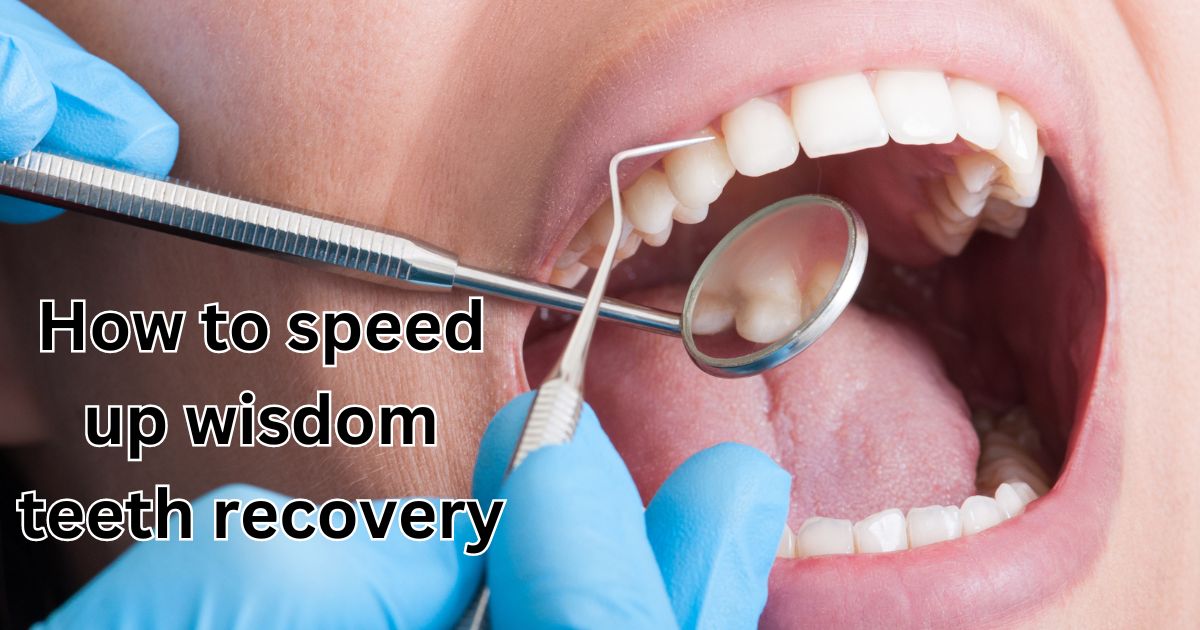Wisdom teeth removal is a common dental procedure, often necessary due to various complications such as impaction, infection, or alignment issues. Despite its routine nature, the recovery process can be challenging, requiring careful attention to ensure a smooth and speedy healing. In this guide, we will explore comprehensive strategies on how to speed up wisdom teeth recovery, providing you with practical tips and insights to enhance your healing process and return to your normal routine as quickly as possible.
Understanding Wisdom Teeth Extraction
What Are Wisdom Teeth?
Wisdom teeth, also known as third molars, are the last set of molars located at the back of the mouth. These teeth typically emerge in late adolescence or early adulthood, usually between the ages of 17 and 25. Their eruption can often lead to various dental issues, including crowding, misalignment, or impaction, where the teeth are unable to fully emerge due to lack of space. Wisdom teeth that do not align properly with the existing teeth can cause discomfort, pain, or infection, making their removal a common dental procedure.
Reasons for Extraction
Several factors can necessitate the extraction of wisdom teeth. The most common reason is impaction, where the teeth are trapped within the jawbone or beneath the gum tissue, unable to emerge properly. This can lead to pain, swelling, and infection. In some cases, wisdom teeth can cause overcrowding, disrupting the alignment of other teeth and complicating orthodontic treatments. Additionally, if a wisdom tooth becomes infected or develops cysts, extraction may be required to prevent further complications and ensure overall oral health.
The Extraction Procedure
The wisdom teeth extraction procedure varies based on the complexity of the case. For a straightforward extraction, local anesthesia is used to numb the area, allowing the dentist or oral surgeon to remove the tooth with minimal discomfort. In more complex cases, such as impacted wisdom teeth, a surgical extraction may be necessary. This involves making an incision in the gum tissue and possibly removing a portion of the bone surrounding the tooth. The procedure typically involves stitches and a longer recovery period, but following proper care instructions can help speed up the healing process.
Immediate Post-Extraction Care
First 24 Hours: Key Tips
The first 24 hours after wisdom teeth extraction are crucial for a smooth recovery. It’s essential to prioritize rest during this period to allow your body to begin the healing process. Avoid strenuous activities and ensure you follow your dentist’s instructions regarding pain management and oral care. Pain and discomfort are common, but over-the-counter pain relievers or prescribed medications can help manage these symptoms. Additionally, applying an ice pack to the outside of your face for the first 24 hours can reduce swelling and provide relief.
Managing Swelling and Bruising
Swelling and bruising are common after wisdom teeth extraction, but there are effective ways to manage these symptoms. Applying an ice pack to the affected area for 15-20 minutes every hour can help reduce swelling. Elevating your head with pillows while resting or sleeping can also minimize swelling by improving blood flow and fluid drainage. Bruising may occur but typically fades within a week or two. If swelling persists or worsens, contact your dentist to ensure there are no complications.
Dietary Recommendations
Diet plays a significant role in how to speed up wisdom teeth recovery. For the first few days, stick to soft foods that are easy to eat and less likely to irritate the extraction sites. Examples include mashed potatoes, yogurt, applesauce, and smoothies. Avoid hot, spicy, or hard foods that can cause discomfort or dislodge blood clots. Staying hydrated is equally important, but be cautious with straws as sucking can dislodge the blood clot and lead to dry socket, a painful complication.
Medications and Pain Management
Pain Relief Options
Effective pain management is crucial for a comfortable recovery. Over-the-counter pain medications like ibuprofen or acetaminophen can alleviate mild to moderate pain and reduce inflammation. If prescribed painkillers by your dentist, follow the instructions carefully and take them as directed. Avoid taking more medication than recommended, as excessive use can lead to side effects. Combining medications with ice packs and rest can help manage pain effectively and contribute to a smoother recovery process.
Antibiotics and Their Role
Antibiotics may be prescribed after wisdom teeth extraction to prevent or treat infection. It’s vital to complete the entire course of antibiotics as directed, even if you start feeling better before finishing the medication. Stopping antibiotics prematurely can lead to antibiotic resistance or incomplete treatment of the infection. Be mindful of potential side effects, such as nausea or diarrhea, and inform your dentist if you experience any adverse reactions.
Natural Pain Relief Methods
In addition to conventional pain relief methods, several natural remedies can help ease discomfort and support the healing process. Herbal remedies such as clove oil, known for its analgesic properties, can be applied directly to the affected area to provide temporary relief. Similarly, chamomile tea bags, when cooled and applied to the extraction site, can help reduce inflammation and soothe pain. However, always consult your dentist before using any alternative remedies to ensure they are safe and appropriate for your situation.
Also Read: Luther social media maven keezy.co
Oral Hygiene and Care
Keeping the Extraction Site Clean
Maintaining oral hygiene is crucial for preventing infection and promoting healing after wisdom teeth extraction. Gently brush your teeth with a soft-bristled toothbrush, avoiding the extraction site to prevent irritation. After 24 hours, you can begin rinsing your mouth with a mild saltwater solution to help keep the area clean and reduce the risk of infection. Be cautious with rinsing, as vigorous swishing can dislodge the blood clot and hinder the healing process.
Avoiding Complications
Complications such as dry socket can significantly impact your recovery. Dry socket occurs when the blood clot at the extraction site is dislodged or dissolves prematurely, exposing the bone and nerves. This condition can be very painful and delay healing. To prevent dry socket, avoid smoking, sucking through straws, and eating hard or crunchy foods. If you suspect you have dry socket or notice persistent pain, contact your dentist for appropriate treatment and advice.
Activities and Lifestyle Adjustments
Rest and Recovery Time
Adequate rest is essential for a quick and smooth recovery after wisdom teeth extraction. Ensure you get plenty of sleep and avoid physical exertion for the first few days. Rest allows your body to focus on healing and reduces the risk of complications. Gradually resume normal activities as you start to feel better, but listen to your body and avoid overexertion. Striking a balance between rest and activity will contribute to a faster recovery and overall well-being.
Avoiding Strenuous Activities
During the initial recovery period, it’s crucial to follow guidelines on how to speed up wisdom teeth recovery by avoiding strenuous activities that can impact the healing process. Activities such as heavy lifting, vigorous exercise, or sports can increase blood flow to the extraction site and potentially lead to complications. Stick to light activities and gradually reintroduce more intense exercises as your recovery progresses. If you have any concerns about resuming specific activities, consult your dentist for personalized guidance on how to ensure a smooth and expedited recovery.
Diet and Nutrition for Faster Healing
Essential Nutrients for Recovery
Proper nutrition plays a vital role in the healing process after wisdom teeth extraction. Focus on consuming a balanced diet rich in essential vitamins and minerals that support tissue repair and overall health. Vitamins A, C, and K are particularly important for healing, as they contribute to collagen production and tissue regeneration. Foods like leafy greens, citrus fruits, and lean proteins are excellent choices. Staying hydrated is equally important, so drink plenty of water to support your body’s healing processes.
Sample Meal Plan
A well-planned meal plan can help ensure you get the necessary nutrients for a speedy recovery. For breakfast, consider options like blended smoothies with fruits and yogurt, or scrambled eggs with soft toast. At lunch and dinner, opt for soft foods such as soups, mashed potatoes, or well-cooked vegetables. Snacks like applesauce or cottage cheese can provide additional nutrients without irritating the extraction sites. Avoiding hard or crunchy foods will help prevent discomfort and promote healing.
Managing Complications
Signs of Infection
Recognizing the signs of infection is crucial for effective management and prevention of further complications. Symptoms such as persistent pain, fever, or swelling that worsens over time may indicate an infection. Additionally, if you notice an unusual discharge or bad taste in your mouth, seek medical attention promptly. Early intervention can prevent the spread of infection and ensure a smoother recovery. Contact your dentist if you have any concerns or notice signs of infection.
Dealing with Dry Socket
Dry socket is a painful condition that can occur if the blood clot at the extraction site is lost. Symptoms include severe pain, a foul odor, and visible bone at the extraction site. If you experience these symptoms, your dentist may need to clean the area and apply a medicated dressing to promote healing. Follow your dentist’s instructions carefully to manage dry socket and avoid further complications. Taking preventive measures, such as avoiding smoking and using straws, can help reduce the risk of developing dry socket.
Addressing Persistent Pain
Persistent pain after wisdom teeth extraction may be a sign of complications or an indication that healing is not progressing as expected. If pain continues beyond the initial recovery period or becomes more severe, consult your dentist to evaluate the situation. Possible causes of persistent pain include infection, improper healing, or complications such as dry socket. Your dentist can provide appropriate treatment options and guidance to address the issue and support your recovery.
Follow-Up Care
Importance of Follow-Up Appointments
Follow-up appointments with your dentist are essential for monitoring your recovery and ensuring that the healing process is proceeding as expected. During these visits, your dentist will check the extraction sites, remove any stitches if necessary, and address any concerns you may have. It’s an opportunity to discuss any symptoms or issues you’ve experienced and receive personalized advice for ongoing care. Regular follow-ups help identify potential complications early and contribute to a successful recovery.
Long-Term Oral Care
Maintaining good oral hygiene and care after wisdom teeth extraction is crucial for long-term health and preventing future issues. Continue practicing proper brushing and flossing techniques to keep your teeth and gums healthy. Consider using an antibacterial mouthwash to reduce the risk of infection and maintain fresh breath. Regular dental check-ups and cleanings will help monitor your oral health and address any emerging concerns. Adopting a proactive approach to oral care will support overall well-being and prevent complications.
Tips from Dental Professionals
Expert Advice on Speeding Up Recovery
Dental professionals offer valuable insights into how to speed up wisdom teeth recovery. According to experts, adhering to post-operative care instructions and maintaining a clean mouth are key factors in accelerating healing. Dr. Jane Smith, an oral surgeon, emphasizes the importance of following dietary recommendations and avoiding activities that could disrupt the healing process. Additionally, Dr. John Doe, a dentist, recommends using cold compresses and staying hydrated to support recovery.
Common Mistakes to Avoid
Several common mistakes can hinder the recovery process and lead to complications. Avoid smoking, as it can delay healing and increase the risk of infection. Refrain from using straws, which can dislodge blood clots and lead to dry socket. Additionally, skipping post-operative care or ignoring dietary restrictions can exacerbate discomfort and prolong recovery. By avoiding these mistakes and following professional advice, you can enhance your recovery and minimize the risk of complications.
Conclusion
In summary, how to speed up wisdom teeth recovery involves a combination of proper care, attention to detail, and adherence to professional advice. By following the guidelines outlined in this article, including immediate post-extraction care, effective pain management, and maintaining good oral hygiene, you can support a faster and smoother recovery. Remember to listen to your body, avoid complications, and seek professional guidance if needed. With the right approach, you’ll be well on your way to a successful recovery and a return to normalcy.
FAQs
1. How long does it take to recover from wisdom teeth extraction?
Recovery time varies but typically takes about 1-2 weeks for initial healing. Full recovery, including bone and gum tissue healing, may take several months.
2. What are the best ways to manage pain after wisdom teeth removal?
Effective pain management includes using prescribed painkillers or over-the-counter medications, applying ice packs to reduce swelling, and resting adequately. Follow your dentist’s instructions for optimal results.
3. How can I prevent dry socket after extraction?
To prevent dry socket, avoid smoking, using straws, and eating hard or crunchy foods. Follow your dentist’s post-operative care instructions carefully and maintain good oral hygiene.
4. When should I contact my dentist after wisdom teeth extraction?
Contact your dentist if you experience severe or persistent pain, signs of infection (such as fever or unusual discharge), or if you suspect you have dry socket. Early intervention can help manage complications effectively.









